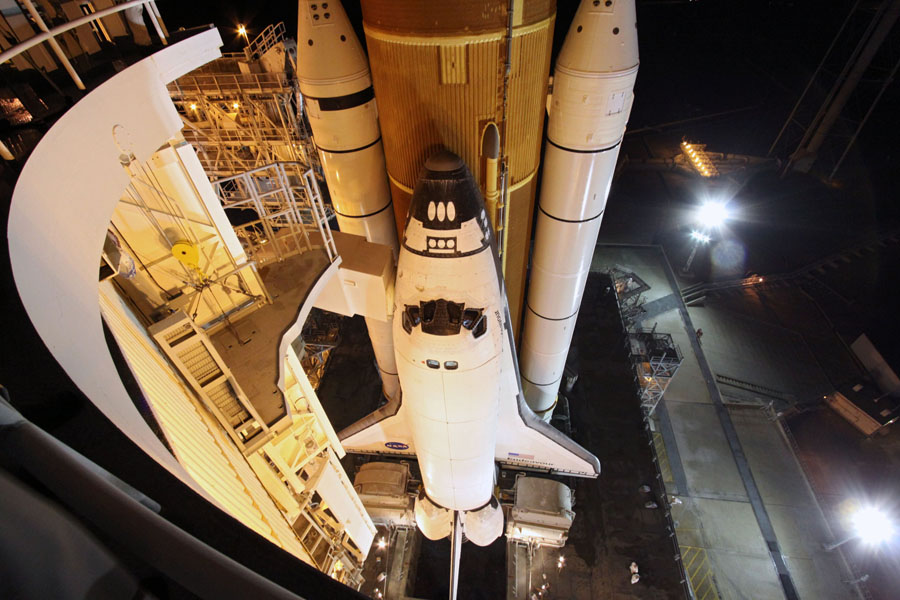NASA Begins Countdown for Next-to-Last Shuttle Launch

The countdown has begun anew for NASA's last launch of the space shuttle Endeavour on Monday (May 16).
Endeavour and its six-astronaut crew will try again to lift off after a power glitch forced NASA to call off an earlier launch attempt April 29. The space shuttle is scheduled to blast off at 8:56 a.m. EDT (1256 GMT) from Kennedy Space Center in Cape Canaveral, Fla.
In the ensuing two weeks engineers checked out the issue and replaced a broken switchbox and wiring that had caused a problem with heaters used to protect the shuttle's hydraulic power system.
"All of those things have been changed out, all the retests of those systems are all complete," NASA test director Jeff Spaulding said during a press conference this morning. "That's all complete and is good and we're ready to go from that perspective." [Most Memorable Shuttle Missions]
NASA began the countdown toward launch today at 7 a.m. EDT (1100 GMT) at T minus 43 hours. The countdown includes a number of scheduled holds before liftoff.
Weather forecasts predict a 70 percent chance of good conditions for launch on Monday. While some storms are expected around the spaceport over the weekend, they are likely to move away by Monday.
"The weather should all be off to the east and southeast, so we expect the conditions to improve," shuttle weather officer Kathy Winters said. "Right now we are forecasting a 30 percent chance of KSC weather prohibiting launch."
Get the Space.com Newsletter
Breaking space news, the latest updates on rocket launches, skywatching events and more!
The main concerns, she said, are a chance of too-strong winds that could pose a risk if the shuttle needed to make an emergency landing at Kennedy Space Center. Even though that event is unlikely, if the weather would prohibit it, the shuttle will not launch. [Video: Endeavour's Final Mission Goals]
On its 25th and final flight, Endeavour will launch an ambitious particle physics experiment to the International Space Station to study dark matter and antimatter. The shuttle is also loaded full of spare supplies to stock up the orbiting laboratory.
The crew plans four spacewalks during their busy 16-day mission.
Endeavour's crew, led by commander Mark Kelly, arrived in Florida on Thursday morning to prepare for launch. Their families, including Kelly's wife, Congresswoman Gabrielle Giffords, D-Ariz., are expected to arrive this weekend.
Giffords is still recovering from a bullet wound to the head after being shot while meeting with constituents in January.
NASA is expecting large crowds to come to Florida's space coast to see the launch, though not quite as many as showed up for the last launch attempt two weeks ago.
"We are expecting probably slightly less than before, just due to the timing," Spaulding said, explaining that an early Monday launch wasn't quite as popular as a Friday afternoon one. "It probably may be down closer to about 500,000 this time."After Endeavour's voyage, NASA will launch one more space shuttle, the July flight of Atlantis, before all the shuttles are retired and sent to museums.
You can follow SPACE.com senior writer Clara Moskowitz on Twitter @ClaraMoskowitz. Visit SPACE.com for complete coverage of Endeavour's final mission STS-134 or follow us @Spacedotcom and on Facebook.
Join our Space Forums to keep talking space on the latest missions, night sky and more! And if you have a news tip, correction or comment, let us know at: community@space.com.

Clara Moskowitz is a science and space writer who joined the Space.com team in 2008 and served as Assistant Managing Editor from 2011 to 2013. Clara has a bachelor's degree in astronomy and physics from Wesleyan University, and a graduate certificate in science writing from the University of California, Santa Cruz. She covers everything from astronomy to human spaceflight and once aced a NASTAR suborbital spaceflight training program for space missions. Clara is currently Associate Editor of Scientific American. To see her latest project is, follow Clara on Twitter.









